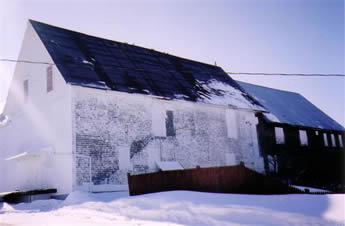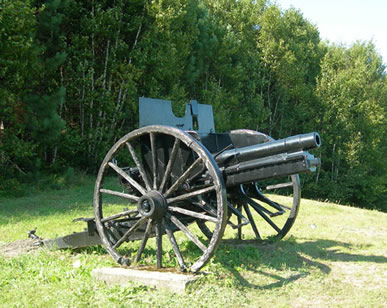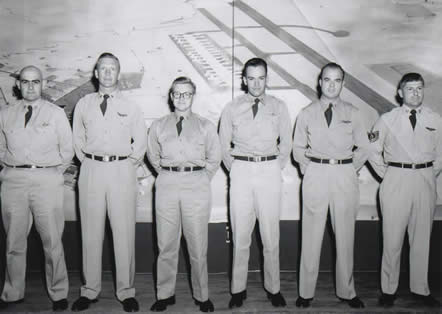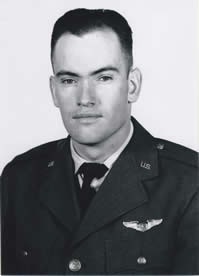VICTORIA COUNTY
Fort Carleton
Grand Falls
| In order to secure the vital lines of communication between Halifax and Quebec City up the St. John River Valley, the first lieutenant governor of New Brunswick, Thomas Carleton, established a military post at Grand Falls in 1790. In May 1791, Lieutenant Dugald Campbell visited the post at Grand Falls and in a letter asked Governor Carleton if it could be called "Fort Carleton". The first garrison consisted of soldiers from the 6th Regiment. In the summer of 1812, the garrison consisted of Sergeant Bishop and three soldiers from the 104th Regiment. In the early 1820s, the post was abandoned once local military settlements were established and government support ended. The Michaud family occupied the old Commissary Storehouse and paid a small rent for it. During the Maine/New Brunswick border dispute, Grand Falls was a strategic location and in 1837 the garrison consisted of a detachment from the 43rd Regiment, until it left for Lower Canada to suppress the Papineau Rebellion. In 1839 the garrison |
 |
The only surviving section of Fort Carleton. It was most
likely the third log barracks. |
| consisted of the Light Company of the 36th Regiment, reinforced by 10 militiamen and a six-pounder cannon for a total of 90 men. During this period a blockhouse was constructed at Grand Falls.
The military post was never a fortified position, but consisted originally of a half dozen squared log buildings alongside the well-known portage that crossed the narrow neck of land separating the upper and lower basins on the St. John River, thereby allowing travellers to avoid the dangerous falls and gorge. The original military reserve totaled about 158 acres. The post was rebuilt in April 1839. It had three log houses capable of accomodating 210 men, plus a cooking house and privy. It soon expanded to include buildings for commissariat and barracks stores, a guard house, gun shed, powder magazine, and was surrounded by a palisade. The last troops departed in 1847 and a caretaker was left in charge of the post. In September 1848, a fire burned two of the log barracks and the storehouse was pulled down to prevent the fire from spreading to the rest of the post. It is believed locally that the old Mulherin Grocery Store, now the Senechale Furniture Company, at the corner of Court and Broadway Streets is the last surviving part of the post, most likely the third log barracks. The unusually wide Broadway Street was the original parade ground. The lower terminus of the original portage around the falls remains, but is overgrown.
|
British Military
Post in Aroostook War
Near Aroostook
As part of Lieutenant
Governor John Harvey's defence plan during the Maine/New Brunswick border dispute,
a British military post was established in 1839 at the mouth of the Aroostook
River, blocking the road to Fort Fairfield. It consisted of the Grenadier Company
of the 36th Regiment with a strength of 80 men, reinforced with 50
militiamen and a six pounder canon.
First World War German Artillery Gun
Corner of Broadway and Court Streets, Grand Falls
On display is German 77 mm field artillery gun, number 8283. It was captured during the Battle of Arras by the 25th Battalion of the Canadian Expeditionary Force on 27 August 1918 at the Moon Quarry, near Cherisy. Along with New Brunswick’s 26th Battalion, the 25th Battalion, a Nova Scotian unit, was part of the Fifth Infantry Brigade, Second Division. On the 27 August 1918, the Fifth Brigade attacked against strong German resistance, but succeeded in capturing the Town of Cherisy and stormed across the River Sensee.
First World War German Field Gun,
Royal Canadian Legion, Perth-Andover
| A First World War German 77 mm field gun is located on the hill overlooking Branch #36 of the Royal Canadian Legion at Perth-Andover. |
 |
The Lieutenant Colonel William Mulherin Armoury
Madawaska Road, Grand Falls
This armoury serves as quarters to “C” Company of the Royal New Brunswick Regiment and as headquarters for 314 Squadron Air Cadets. It is named in honour of Lieutenant Colonel William (Billy) Mulherin. He was born on 22 June 1922, the son of Gladys (Estey) Mulherin and Herbert Mulherin, ex-mayor of Grand Falls. Mulherin attended school in Grand Falls and after graduating from the Royal Military College, was posted to the Princess Patricia’s Canadian Light Infantry. He saw action in World War Two with the PPCLI in both Italy and North West Europe. After the war, he commanded the Carleton and York Company of the 1st Canadian Infantry Battalion in Germany, served in Indochina, attended the Australian Staff College and commanded the 1st Battalion of the Canadian Guards. He died on 5 April 1966 en route to the Hook of Holland and is buried in Brookwood Cemetery, Surrey, England.
Loring Air Force
Base
Limestone, Maine, USA
The second largest
of USA's 21 Strategic Air Command bases. It was built in 1953 for 100 B-36 bombers,
but later they were replaced by B-52 bombers and KC-135 air tankers. It had
two runways and a peak military population of some 10,000, including three army
anti-aircraft defence sites, with one of these missile sites sited right on
the international border. Located in the most northeasterly corner of continental
United States it was ideally positioned for potential Cold War conflicts in
western Soviet Union, Europe and the Middle East. In 1976, the base received
a $300 million upgrade. Although the base was used in the deployment for the
Gulf War in 1991, with the end of the Cold War, it was closed in 1994. This
base had a major economic and social impact on northwestern New Brunswick, including
putting the area directly in the front line if a nuclear war had occurred.
Crash Site of a
B-52 Bomber
East of Trans-Canada Highway near Morrill Siding
At 12:05 p.m. on Friday 10 January 1957, a B-52 intercontinental bomber from the 70th Bomb Squadron, stationed at the Strategic US Air Force Command Base at Loring, Maine, exploded and crashed near Morrill Siding, five miles north of Perth-Andover. Traces of the wreckage can still be found. On board were the six crew members and three instructors. Eight airmen in all were killed, while the co-pilot, Captain Joseph L. Church, miraculously survived, parachuting to safety. The bomber was returning from a routine instrument training mission and was undergoing an exercise designed to test the pilot's reflexes. The pilot's vision was partially restricted, most likely by a hood, and then the aircraft was placed in "an unusual position." The pilot was expected to take the appropriate action to regain control of the aircraft. On this occasion something went drastically wrong. The stress placed on the airframe caused it to break apart and explode. This was the fourth crash of a B-52 in eleven months.
|
 |
This is the B-52 bomber crew on completion of its training at Castle Air
Force Base, Merced, CA. |
The victims of this tragedy are:
Captain William C. Davidson, Pilot Instructor, age 40, married, buried Hanford, California.
Captain Richard A. Jenkins, Pilot, age 35, married, buried in Huron, Ohio.
Captain John E. McCune, Pilot Instructor, age 31, married, buried Hayward, California.
Captain Marquad H. D. Myers, Pilot Instructor, age 35, married, buried Tracey, California.
Lieutenant Charles S. Cole, Navigator, age, 27, married, buried Basin, Wyoming.
Lieutenant Andy Larson, Observer EOM Operator, married, age 26, buried New York City.
Lieutenant Walter A. Thomas, Early Warning EW Operator, age 33, buried Youngstown, Pennsylvania.
Sergeant Ray Miller, Tail-Gunner, married, age 27, buried Racine, Wisconsin. |
The fate of the aircraft's navigator epitomizes the human cost of the Cold War. Lieutenant Charles Samuel Cole completed his training with his crew at Castle Air Force Base in Merced, California in June 1956, after which they were assigned to 70 Bomb Squadron. He married Theresa Jalbert of Caribou, Maine, and the couple took up residence on Church Street in her home town. Within the year, he was killed at age 26 and was buried in his hometown of Basin, Wyoming. One week after the crash, his widow gave birth to their only child, a son named John who would never know his father.
|
 |
Crash site of a
KC-135 Air Tanker
Carlingford near the border off Highway #7
On October 4th 1989 a KC-135 from Loring Air Force Base crashed near Carlingford, killing four
crew members.
Top of page
|

